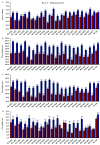Molecular Diversity and Combining Ability in Newly Developed Maize Inbred Lines under Low-Nitrogen Conditions
- PMID: 38792661
- PMCID: PMC11122723
- DOI: 10.3390/life14050641
Molecular Diversity and Combining Ability in Newly Developed Maize Inbred Lines under Low-Nitrogen Conditions
Abstract
Nitrogen is an essential element for maize growth, but excessive application can lead to various environmental and ecological issues, including water pollution, air pollution, greenhouse gas emissions, and biodiversity loss. Hence, developing maize hybrids resilient to low-N conditions is vital for sustainable agriculture, particularly in nitrogen-deficient soils. Combining ability and genetic relationships among parental lines is crucial for breeding superior hybrids under diverse nitrogen levels. This study aimed to assess the genetic diversity of maize inbred lines using simple sequence repeat (SSR) markers and evaluate their combining ability to identify superior hybrids under low-N and recommended conditions. Local and exotic inbred lines were genotyped using SSR markers, revealing substantial genetic variation with high gene diversity (He = 0.60), moderate polymorphism information content (PIC = 0.54), and an average of 3.64 alleles per locus. Twenty-one F1 hybrids were generated through a diallel mating design using these diverse lines. These hybrids and a high yielding commercial check (SC-131) were field-tested under low-N and recommended N conditions. Significant variations (p < 0.01) were observed among nitrogen levels, hybrids, and their interaction for all recorded traits. Additive genetic variances predominated over non-additive genetic variances for grain yield and most traits. Inbred IL3 emerged as an effective combiner for developing early maturing genotypes with lower ear placement. Additionally, inbreds IL1, IL2, and IL3 showed promise as superior combiners for enhancing grain yield and related traits under both low-N and recommended conditions. Notably, hybrids IL1×IL4, IL2×IL5, IL2×IL6, and IL5×IL7 exhibited specific combining abilities for increasing grain yield and associated traits under low-N stress conditions. Furthermore, strong positive associations were identified between grain yield and specific traits like plant height, ear length, number of rows per ear, and number of kernels per row. Due to their straightforward measurability, these relationships underscore the potential of using these traits as proxies for indirect selection in early breeding generations, particularly under low-N stress. This research contributes to breeding nitrogen-efficient maize hybrids and advances our understanding of the genetic foundations for tolerance to nitrogen limitations.
Keywords: genetic diversity; hybrid breeding; microsatellite markers; nitrogen deficiency; sustainable agriculture.
Conflict of interest statement
The authors declare no conflicts of interest.
Figures







Similar articles
-
Molecular diversity and genetic potential of new maize inbred lines across varying sowing conditions in arid environment.Sci Rep. 2025 Jan 22;15(1):2809. doi: 10.1038/s41598-025-87021-8. Sci Rep. 2025. PMID: 39843541 Free PMC article.
-
Genetic Potential of Newly Developed Maize Hybrids under Different Water-Availability Conditions in an Arid Environment.Life (Basel). 2024 Mar 29;14(4):453. doi: 10.3390/life14040453. Life (Basel). 2024. PMID: 38672723 Free PMC article.
-
Molecular Genetic Diversity of Local and Exotic Durum Wheat Genotypes and Their Combining Ability for Agronomic Traits under Water Deficit and Well-Watered Conditions.Life (Basel). 2023 Dec 1;13(12):2293. doi: 10.3390/life13122293. Life (Basel). 2023. PMID: 38137895 Free PMC article.
-
Combining Ability and Inheritance Nature of Agronomic Traits and Resistance to Pink Stem (Sesamia cretica) and Purple-Lined (Chilo agamemnon) Borers in Maize.Plants (Basel). 2023 Mar 1;12(5):1105. doi: 10.3390/plants12051105. Plants (Basel). 2023. PMID: 36903963 Free PMC article.
-
Identification of early and extra-early maturing tropical maize inbred lines resistant to Exserohilum turcicum in sub-Saharan Africa.Crop Prot. 2021 Jan;139:105386. doi: 10.1016/j.cropro.2020.105386. Crop Prot. 2021. PMID: 33390640 Free PMC article. Review.
Cited by
-
Exploring molecular variation and combining ability of local and exotic bread wheat genotypes under well-watered and drought conditions.PeerJ. 2025 Feb 27;13:e18994. doi: 10.7717/peerj.18994. eCollection 2025. PeerJ. 2025. PMID: 40034662 Free PMC article.
-
Unravelling agronomic performance and genetic diversity of newly developed maize inbred lines for arid conditions.PeerJ. 2025 Jun 27;13:e19598. doi: 10.7717/peerj.19598. eCollection 2025. PeerJ. 2025. PMID: 40589859 Free PMC article.
-
Unraveling Genetic Variation and Inheritance Patterns in Newly Developed Maize Hybrids for Improving Late Wilt Disease Resistance and Agronomic Performance Under Artificial Inoculation Conditions.Life (Basel). 2024 Dec 5;14(12):1609. doi: 10.3390/life14121609. Life (Basel). 2024. PMID: 39768317 Free PMC article.
-
Comparative Analysis of Physiological Parameters, Antioxidant Defense, Ion Regulation, and Gene Expression in Two Distinct Maize Hybrids Under Salt Stress at Seedling Stage.Life (Basel). 2025 Apr 3;15(4):591. doi: 10.3390/life15040591. Life (Basel). 2025. PMID: 40283149 Free PMC article.
-
Cultivar specific nitrogen and potassium recommendations optimize yield and quality attributes in sugar beet.Sci Rep. 2025 Jul 29;15(1):27550. doi: 10.1038/s41598-025-10918-x. Sci Rep. 2025. PMID: 40730601 Free PMC article.
References
-
- FAOSTAT Food and Agriculture Organization of the United Nations. Statistical Database. 2024. [(accessed on 3 January 2024)]. Available online: http://www.fao.org/faostat/en/#data.
-
- Wang H., Ren H., Zhang L., Zhao Y., Liu Y., He Q., Li G., Han K., Zhang J., Zhao B. A sustainable approach to narrowing the summer maize yield gap experienced by smallholders in the North China Plain. Agric. Syst. 2023;204:103541. doi: 10.1016/j.agsy.2022.103541. - DOI
-
- Mukri G., Patil M.S., Motagi B.N., Bhat J.S., Singh C., Jeevan Kumar S., Gadag R., Gupta N.C., Simal-Gandara J. Genetic variability, combining ability and molecular diversity-based parental line selection for heterosis breeding in field corn (Zea mays L.) Mol. Biol. Rep. 2022;49:4517–4524. doi: 10.1007/s11033-022-07295-3. - DOI - PMC - PubMed
-
- Bakala H.S., Devi J., Ankita, Sarao L.K., Kaur S. Agroindustrial Waste for Green Fuel Application. Springer; Singapore: 2023. Utilization of wheat and maize waste as biofuel source; pp. 27–66. Clean Energy Production Technologies. - DOI
Grants and funding
LinkOut - more resources
Full Text Sources

